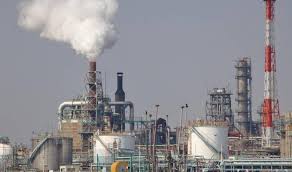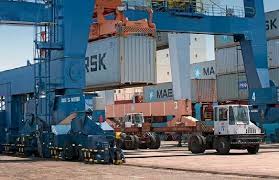Kenya’s 2027 Economic Vision: Industrializing Blue Economy to Become Africa’s Gateway

Industrialization going on in other countries (Photo/ Courtesy)
By Andrew Mwangura
Email, thecoastnewspaper@gmail.com
As Kenya approaches the pivotal year of 2027, with its elections looming as a potential turning point, the nation’s economic agenda demands a radical shift toward bold industrialization. This is not merely an option but an imperative, particularly for the Coast region, where untapped potential could transform Kenya into the unequivocal gateway to Africa and Africa to the world.
At the heart of this vision lies the Blue Economy—the sustainable harnessing of oceanic and maritime resources—which represents industrialization at its most innovative and inclusive.
Yet, realizing this ambition requires more than policy documents or infrastructure blueprints; it calls for great thinkers and free thinkers who can break free from conventional constraints, foster creativity, and drive a renaissance in economic strategy.
Kenya’s current economic landscape, while showing resilience, is plagued by persistent challenges that underscore the urgency of this pivot.
Unemployment hovers around 5.7 percent nationally, but in coastal counties like Mombasa and Kilifi, youth joblessness exceeds 20 percent, fueling social unrest and inequality.
Agriculture and services dominate the GDP, contributing over 50 percent combined, yet manufacturing lags at just 7.6 percent, far below the Vision 2030 target of 15 percent by 2030.
The Coast region, home to over 4.3 million people and boasting 536 kilometers of coastline, has long been sidelined, its economy reliant on tourism and small-scale fishing that generate meager returns.
Ports like Mombasa handle 30 million tons of cargo annually, serving landlocked neighbors such as Uganda and South Sudan, but inefficiencies and underinvestment limit their role as a continental hub.
Climate change exacerbates these issues, with rising sea levels threatening mangroves and fisheries, which support 60,000 artisanal fishers and contribute KSh 26 billion to the economy yearly.
Industrialization through the Blue Economy offers a pathway to address these woes while positioning Kenya as Africa’s premier entry point. Imagine the Coast not as a peripheral zone but as the epicenter of a thriving maritime industrial complex.
The Blue Economy encompasses sectors like sustainable fisheries, aquaculture, maritime transport, offshore renewables, and eco-tourism, projected to grow globally to $3 trillion by 2030.
For Kenya, this means leveraging the Indian Ocean as a conduit for trade, innovation, and connectivity.
The government’s Bottom-Up Economic Transformation Agenda (BETA), outlined in the Fourth Medium Term Plan (2023-2027), already hints at this potential, with commitments to develop value chains in fisheries and leather, establish Special Economic Zones (SEZs) like Dongo Kundu in Mombasa, and invest KSh 3 billion in maritime infrastructure.
Dongo Kundu, for instance, could become a manufacturing powerhouse for agro-processing and textiles, creating 100,000 jobs and boosting exports by processing tuna and seaweed into high-value products for global markets.
This agenda would make Kenya the gateway by enhancing its logistical supremacy.

The Lamu Port-South Sudan-Ethiopia Transport (LAPSSET) Corridor, with its first berth operational and plans for expansion, could link East Africa to global supply chains, reducing transit times and costs.
Coupled with upgrades to Mombasa Port, including deeper berths and cruise terminals, Kenya could handle 50 million tons of cargo by 2030, serving as the entry for African Continental Free Trade Area (AfCFTA) goods.
The Blue Economy’s emphasis on sustainability—through mangrove restoration covering 1,400 hectares and regulations against overfishing—ensures long-term viability, attracting green investments from partners like the
European Union via the Go Blue Project. This initiative, targeting six coastal counties (Kilifi, Kwale, Lamu, Mombasa, Taita Taveta, Tana River), focuses on job creation in aquaculture and eco-tourism, potentially adding 50,000 employment opportunities while conserving marine ecosystems.
Beyond infrastructure, industrialization demands innovation in human capital and governance.
Training programs, such as those at Bandari Maritime Academy, could reskill 3,000 youth for international shipping roles, while digital hubs in Mombasa integrate AI into logistics, making Kenya a tech-savvy gateway. Yet, current efforts fall short due to bureaucratic inertia and political patronage, which stifle entrepreneurship.
This is where great thinkers and free thinkers become indispensable.
Kenya needs visionaries unbound by tribal politics or short-term gains—economists, engineers, and entrepreneurs who can design public-private partnerships, advocate for tax incentives in SEZs, and integrate circular economy principles to recycle marine waste into products.
Free thinkers would challenge outdated regulations, promoting cabotage policies that reserve coastal shipping for Kenyan vessels and fostering startups in offshore wind energy, which could power industrial parks sustainably.
The benefits of this agenda extend nationwide. Industrialization via the Blue Economy could raise GDP growth to 7 percent annually, reduce poverty in the Coast from 35 percent to under 20 percent, and enhance foreign exchange through diversified exports like processed fish and leather goods.
As Africa’s demographic dividend swells with a youthful population, this approach ensures inclusive growth, empowering women in aquaculture and marginalized communities in tourism.
Moreover, by leading in sustainable maritime practices, Kenya positions itself as a model for the continent, hosting summits like the recent IOC-UNESCO event on ocean economies and influencing regional blocs like the East African Community.
In conclusion, the economic agenda for 2027 and beyond must center on industrializing the Blue Economy to forge Kenya as the gateway to Africa.

This is not a distant dream but a feasible reality, building on Vision 2030’s foundations and BETA’s inclusivity. However, it hinges on cultivating great thinkers—those who dare to innovate—and free thinkers who question the status quo.
Policymakers, educators, and citizens must rally around this vision, investing in education, research, and bold reforms. If embraced, Kenya will not only unlock the Coast’s riches but also propel the nation into a prosperous, interconnected future, where the ocean waves carry waves of opportunity for all.
The author is a policy analyst specializing in maritime governance and blue economy development.






